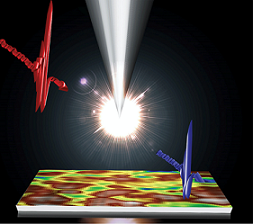
A team from the DOE’s Ames National Laboratory has developed a microscope that uses terahertz waves to collect data on material samples. This new characterization tool is also unique in that it shines the terahertz light through a sharp metallic tip that enhances the microscope’s capabilities toward nanometer-length scales.
“Normally if you have a light wave, you cannot see things smaller than the wavelength of the light you’re using. And for this terahertz light, the wavelength is about a millimeter, so it’s quite large,” explained Richard Kim, a scientist from Ames Lab. “But here we used this sharp metallic tip with an apex that is sharpened to a 20-nanometer radius curvature, and this acts as our antenna to see things smaller than the wavelength that we were using.”
The team of researchers used the new microscope to investigate a perovskite material – Methylammonium Lead Iodide (MAPbI3) perovskite – as a possible alternative to silicon in solar cells. The main problem with using MAPbI3 in solar cells is that it degrades easily when exposed to elements like heat and moisture.
They expected MAPbI3 to behave like an insulator when they exposed it to the terahertz light. As the data collected on a sample is a reading of how the light scatters when the material is exposed to the terahertz waves, they expected a consistent low-level of light scatter throughout the material. However, they found that there was a lot of variation in light scattering along the boundary between the grains. The wide variation of light scattering detected along the grain boundaries provided insights into the material’s degradation problem.
“We believe that the present study demonstrates a powerful microscopy tool to visualize, understand and potentially mitigate grain boundary degradation, defect traps, and materials degradation,” said team lead Jigang Wang. “Better understanding of these issues may enable developing highly efficient perovskite-based photovoltaic devices for many years to come.”
